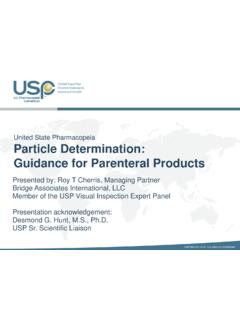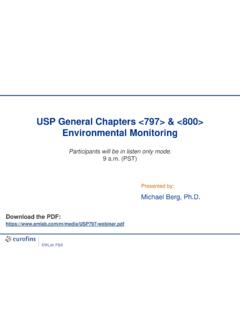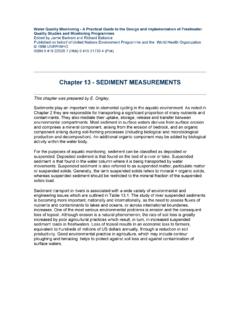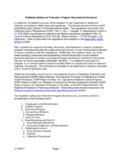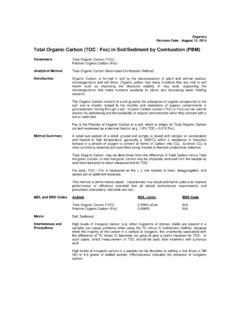Transcription of Lubricant Analysis Condition-monitoring fundamentals
1 Mobil ServSM Lubricant Analysis Condition-monitoring fundamentals Table of contents . Table of contents Introduction to sampling Interpreting Introductionresults to sampling . Mobil ServSM Lubricant Analysis Interpreting your Analysis results . What and when to sample Mobil Serv Lubricant Analysis sample report . Selecting a Mobil Serv Lubricant Analysis service . Taking corrective action . Proper sampling techniques Understanding equipment condition . Taking a representative sample Understanding contamination . Sampling and scanning instructions Understanding Lubricant condition . Inspecting your sample Engine operating conditions . Lubricant viscosity grade comparisons . Mobil Serv Lubricant AnalysisSM offers an Find the appropriate Technical Help Desk innovative oil Analysis program backed by contact number here: How to: industry-leading application expertise.
2 Technical Help Desk . Get help If you have questions or need assistance contact your local ExxonMobil sales representative or our Technical Help Desk. 2. Introduction to sampling Proper sampling techniques Interpreting results Taking corrective action Mobil ServSM Lubricant Analysis Condition-monitoring fundamentals In today's industry, condition-based maintenance practices have gained widespread acceptance. Key industry leaders increasingly realize that oil Analysis is a critical component in any equipment monitoring program. A successful oil Analysis program can help: Improve Reduce Enhance equipment reliability maintenance costs equipment life Mobil ServSM Lubricant Analysis simplifies the lubrication monitoring process while producing reliable results that help guide maintenance professionals to the best decisions for their operations.
3 Mobil Serv Lubricant Analysis provides informative reports on the condition of your equipment and Lubricant , backed by the unmatched flexibility, expertise, and quality assurance of ExxonMobil. Flexibility Perform many tasks more efficiently with Mobil Serv Lubricant Analysis online capabilities. Expertise Through global Original Equipment Manufacturer (OEM) relationships and hands-on lubrication experience, Points to consider ExxonMobil supports your maintenance activities. Oil Analysis Quality Make decisions with confidence by leveraging the quality assurance offered by ExxonMobil. Oil Analysis is an effective Condition-monitoring tool. Additional equipment monitoring practices (inspections, vibration, operator logs, etc.) can be implemented to further enhance the value of your overall equipment reliability program.
4 How to: 1. Establish goals and metrics 2. Obtain management commitment 6. Respond to Analysis results 7. Measure program results versus goals Establish and 3. Train and educate personnel and metrics maintain a successful 4. Identify equipment and sample 8. Review and modify program oil Analysis program frequencies 9. Document savings 5. Implement the program 3. Introduction to sampling Proper sampling techniques Interpreting results Taking corrective action What and when to sample Oil Analysis is most effective as a diagnostic tool when samples are taken from the appropriate equipment at scheduled intervals. 1. D. etermine what to sample Consider the five general factors listed below when selecting equipment for the program, and refer to your OEM manual for guidance on recommended sample frequency.
5 Target sample Economic impact Operating environment Fluid age factor Equipment age factor results of failure High dirt/dust environment Hours/miles/ Hours/miles/kilometers Above control limits Safety risk kilometers since High loads/pressures/speeds last change Rated life expectancy Within control limits Operational criticality High temperatures Oxidation, Make and model number Repair costs contamination Low temperatures Downtime cost Synthetic, premium, Chemical contamination mineral Lost production Wet environment Spared unit 2. D. etermine when to sample A regular pattern of sampling will establish a credible historical trend of equipment performance. If you don't have OEM-recommended sample interval guidelines, refer to the table below for general guidance in establishing initial sample frequency.
6 Industrial/plant equipment Off-highway equipment On-highway equipment Application Frequency Application Frequency Application Frequency Landfill gas engine 250 hours Diesel engine 250 hours Diesel engine 25,000 km or 15,000 mi. Generator engine 500 hours Wheel motor 250 hours Transmission 500 hrs, 40,000 km, or 25,000 mi Natural gas engine 500 hours Differential/gear 500 hours Hydraulic system 500 hrs, 40,000 km, or 25,000 mi Paper machine lube system Monthly Hydraulic system 500 hours Turbine Monthly Transmission 500 hours Compressor 3 months Final drive 1,000 hours Gear drive 3 months Hydraulic system 3 months 4. Introduction to sampling Proper sampling techniques Interpreting results Taking corrective action Selecting a Mobil ServSM Lubricant Analysis service Visit.
7 Analysis options*. Mobil ServSM Lubricant Analysis provides you with Analysis options based on your equipment's application and the desired Analysis service level. These service level options use the 4-ounce (120 ml) bottle kit. Service option Description Essential Analysis Delivers the essential application-specific Analysis to help you assess equipment wear, contamination and oil condition Enhanced Analysis Delivers additional enhanced tests for more comprehensive Analysis ( , hydraulic/circulating systems-particle count, particle quantifier index; or engines - base number, particle quantifier index). Elite Analysis Delivers a unique level of testing for limited applications that operate under demanding conditions ( , precision hydraulic applications).
8 Extended service Analysis options*. The criticality of maintaining operations may require an advanced level of Analysis . These extended service Analysis options (available only for select applications) are designed to support equipment reliability decisions. For extended service level options, use the metal 1 liter tin kit. Service option Description Suitability for Performs additional tests to determine whether the in-service oil is continued use suitable for continued use ( , rotation pressure vessel oxidation test Analysis (SCU) (RPVOT), foam, demulsibility). Recommended on an annual frequency. Varnish Performs additional tests to identify indicators of varnish in critical systems prediction ( , membrane patch colorimetry (MPC), RULER phenolic, and RULER - Analysis (VPA) amine).
9 Recommended on a quarterly or annual frequency. Maximum service Combines the Analysis of suitability for continued use and varnish Analysis (MSA) prediction Analysis to help improve reliability and detect problems before they result in costly downtime or expensive repairs. Recommended on a quarterly or annual frequency. * Analysis may vary by laboratory, product supplied or oil condition. For more information about choosing the Analysis service that best fits your needs, contact your ExxonMobil representative or visit 1. D etermine the Analysis options required Request Mobil ServSM Lubricant Analysis kits for your program goals from your authorized ExxonMobil Distributor How to: 2. I dentify the Mobil Serv service level for your Analysis *. or local ExxonMobil representative.
10 Obtain sample kits 3. R equest the appropriate Mobil Serv sampling kit 5. Introduction to sampling Proper sampling techniques Interpreting results Taking corrective action Taking a representative sample When, where, and how you sample impacts the quality of your results. To obtain accurate Analysis , start with a representative sample. Sample at a consistent frequency, from the same sample location, using proper sampling techniques. For best results: 1. Establish a sampling schedule. Integrate the schedule with your planned maintenance. Sample from the same sampling point and at a consistent sample interval. Sample at operating temperature through a sampling valve, vacuum pump or sampling tube. Use caution when oil is above 120 F (50 C). 2. Follow good housekeeping techniques.

